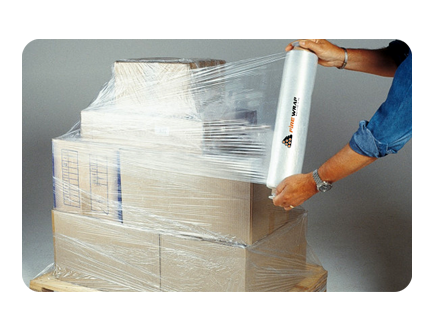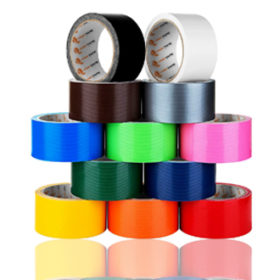Stretch Wrap
Find Out How to Wrap a Pallet By Hand in 7 Easy Steps
Pallet wrap is a highly flexible film that is also known as “stretch film” or “stretch wrap.” It’s most typically used to wrap around palletized objects. The articles are tightly bonded and entirely secured during transit thanks to the elastic recovery.
Product loss and tampering are decreased when the load is secured. Certain weather conditions, dust, and light particles can also be shielded from goods. Stretch films that are black or tinted are suitable for transporting products that cannot be exposed to direct sunlight, such as electronic gadgets.
Pallet wrap is commonly used in industries, manufacturing, and storage since it is versatile and long-lasting. Many ordinary goods, such as furniture, windows, and food packaging, can be made out of it.
Pallet wrap is a low-density polyethylene film that is widely used to wrap pallets (LLDPE). The production process entails heating and compressing resin (tiny pellets of plastic material) to the desired viscosity at a certain temperature. The plastic is then pushed through an annular die to form a continuous layer. Other resins and additives, such as pigment, tackifier, and UV resistance, can be used.

Only seven steps separate you from the ideal hand wrapping strategy for your next pallet. Learn with us the best method to select while hand wrapping a pallet.
1.Locate the Ideal Pallet for the Project
The choice of the pallet has a significant impact on the final product. After all, it’s the basis throughout your whole load, so you want to be sure it’s solid. You may simply go on to the finest approach to wrapping a pallet after you have the correct pallet.
So, what should you be looking for while selecting the ideal pallet wrap?
To begin, you must first locate a pallet that is the appropriate size for your items. You must choose an excellent pallet once you’ve discovered the proper fit. Avoid any splitting corners or fractured planks that might compromise your stability. You can continue on to the following stage once you’ve identified the suitable pallet wrap.
2. Assemble Your Pallet
This stage may appear self-explanatory, but stacking your parcels is an art. Make sure they’re as close together as practicable; less distance between components means less danger of your completed pallet wrap coming loose in shipment!
To make the most out of your capacity without jeopardizing load integrity, breakage, or even looping around difficult angles, place your items as close to the pallet’s edge as possible without falling off the edge.
Start with the largest and heaviest things at the bottom of your stack and work your way up to lighter and smaller bundles. To decrease the danger of destruction in shipping, ensure the contents are contained inside the pallet’s limitations.
3.Glue the Wrap On
Choose your pallet wrap — a pre-stretched film, such as Carewrap, is better since it takes less exertion to wrap and has a higher holding ability. If your product requires to ‘breathe,’ you might require a perforated wrap like Ventiwrap.
Remove a few feet of pallet wrap film from the roll. Make a loose rope out of approximately eight inches of the wrap’s end and weave it around the outside of a corner of the pallet. Fasten with a tie.
4. Your Load Should be Wrapped
You must first pick your hand pallet wrap before you can secure your products. There are a variety of options available to make hand wrapping a pallet a quicker and easier operation, but make sure you select one that is stretchable and strong. We have a large collection that you may look through here.
Peel a few feet from your roll and make a rope including almost eight inches of wrap, then knot it around the outside of a corner of the pallet’s foundation. Begin wrapping at the bottom of your pallet including at minimum four components pulled tight around that one.
5. Make Your Way Up to the Top
All you have to do now is progressively work your way up to your stack once you’ve tightly wrapped your foundation. For added protection, assure each layer of pallet wrap overlaps the previous one. Then when you’ve reached the summit, simply navigate your way back down to the bottom to provide the best possible stability and mitigate the possibility of destruction to your items during mass transportation.
6.Keep Your Pallet Wrap in Place
It’s important to execute and fasten your hand pallet wrap packaging after you’re satisfied it’s safe and won’t budge about on the trip to its objective. Tear the packaging and tuck it behind one of the pallet’s corners, or fasten it to the pallet’s bottom.
Split the wrap and adhere the end towards the container or tuck something behind one of the pallet’s borders after it’s finished.
7.Check the stability of your load
You’re prepared to go on to the next stage as soon as your pallet wrap is securely fastened. It’s important to ensure your cargo doesn’t move about while in transit.
Lastly, inspect the load stability to guarantee that the cargo will not move during travel. If you press the higher things and they aren’t unfastened, you’re accomplished. It’s considerably easy than you may expect to test load resilience; all it takes is a modest push to the modules on top of your stack.
Still unsure if you have packed it up correctly?
Contact our company Fire Tape to help you out with our professional services.
You’ve wrapped your pallet effectively if they remain put!
How to pack and ship fragile items
Conclusion
We recognize that product manufacture and distribution may be difficult enough on their own, and we also acknowledge that each business is unique. That is why we adopt a unique packaging strategy for each of our clients, getting to know each business’s specific requirements. Our free consultation allows us to examine a company in-depth and determine how we can assist in making changes. Fire Tape will go above and beyond to locate the packaging items and strategies that will completely revolutionize your business.

 All Products
All Products